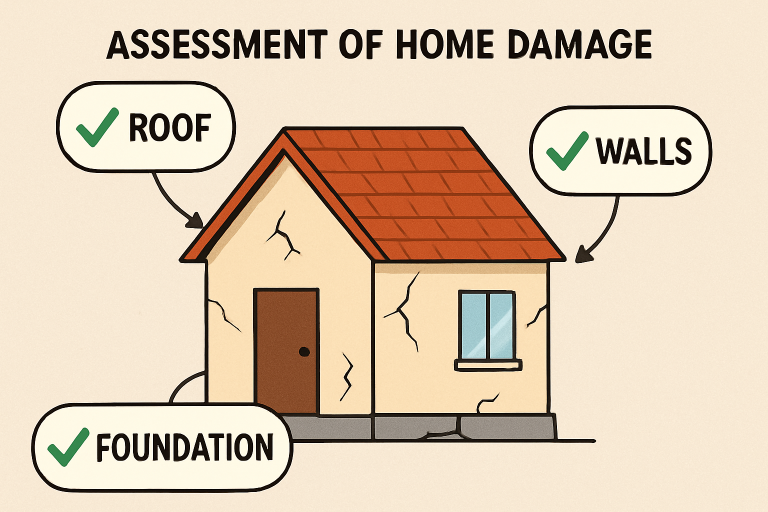Home restoration is more than just repairing damage—it’s about bringing back safety, comfort, and value to your living space. Restoring your home after it has been damaged, whether by water, fire, storms, or age, can be overwhelming. The right approach and trusted restoration services make a world of difference—saving you time, money, and unnecessary stress. Tackling restoration with a plan ensures each decision protects your home’s value and your peace of mind.
When pursuing a comprehensive home restoration, homeowners owe it to themselves to stay informed and select partners who deliver skilled assessments and quality work. Mishandling the process can result in increased costs and future problems. Instead, understanding the essentials of restoration empowers you to safeguard your property and improve its comfort for years to come.
Table of Contents
Assessing the Damage
Successful home restoration always begins with a detailed assessment. Start with a thorough visual inspection, looking for telltale signs such as water stains on ceilings, mold patches behind furniture, warped flooring, or visible cracks in walls. The sooner you identify these issues, the easier and more affordable they are to address.
Even with visible clues, many problems—like hidden moisture, compromised wiring, or weakened structural supports—require a professional’s trained eye. Hiring certified inspectors increases your chances of catching these issues early, which can save you from exponential costs down the road. The Institute of Inspection, Cleaning and Restoration Certification (IICRC) notes that unresolved water damage accelerates rapidly, underscoring the need for swift action.
It is equally important to document all damage and track repair needs. Effective documentation not only guides the restoration process but also strengthens insurance claims should you need to recoup your expenses.
Once you understand the scope of repair, you can prioritize issues based on urgency and set proper expectations for your restoration timeline and budget.

Choosing the Right Restoration Professionals
With a clear understanding of the damage, the next step is selecting the right team. Reliable contractors or restoration specialists are central to restoring your home safely and efficiently. Choose companies with stellar reviews, proof of licensing, comprehensive insurance, and clear, consistent communication.
Gathering multiple quotes ensures you receive fair pricing and learn about different approaches to your project. Don’t be afraid to ask for references or examples of past work; qualified professionals will be happy to share their expertise and customer feedback. For large-scale repairs, seek out companies that follow recognized standards, such as those set by the IICRC. A strong partnership with your restoration specialist helps guarantee a smoother, more transparent process from start to finish.
Budgeting for Your Restoration Project
Restoration costs can add up quickly without a comprehensive budget. Itemize all anticipated expenses, including materials, labor, permits, inspections, and a 10-20% contingency fund for unforeseen complications. Consider not only the apparent repairs but also any outdated elements of the home that may need upgrading to comply with new codes or prevent future incidents.
The most efficient restoration projects are based on a solid financial plan. Beyond protecting yourself from overages, a well-structured budget helps maintain momentum when surprises inevitably arise. For guidance on average costs or what to expect for specific restoration services, publications like Consumer Reports provide reliable insight for homeowners.
Preventing Future Damage
Once your home is restored, your job as a homeowner continues with prevention. Regular maintenance on your home’s critical systems is essential—schedule annual inspections for your roof, plumbing, HVAC, and electrical systems. Early detection of leaks, blockages, or deterioration will reduce your risk of severe damage in the future.
Consider installing modern technologies, such as smart water sensors or leak detectors, in at-risk areas. These devices send alerts straight to your phone if they detect excessive moisture, helping you prevent mold or water damage before it starts (The New York Times).
Proper ventilation also prevents moisture accumulation—especially in basements, bathrooms, and attics—thus reducing the risk of mold and mildew. Don’t overlook landscape grading; ensure drainage leads water away from your foundation. Preventive measures now will save significant restoration costs and hassle later.
Understanding Insurance Coverage
Understanding your homeowner’s insurance is vital when disaster strikes. Not every policy covers every kind of damage, so review your coverage details and ask your provider clarifying questions before you need to file a claim. Take photos and retain receipts for all repairs and restoration work, as robust documentation will help streamline your claims process. The more accurately you can detail the damage and restoration process, the more likely you are to recover expenses through your insurance policy (Consumer Reports).
Maintaining Your Restored Home
The final phase in the restoration journey is ongoing maintenance. Set up a schedule for seasonal checks—look for indications of leaks, cracks, settling, or signs of pests. Addressing minor issues as soon as they arise prevents major repairs and maintains the value of your investment.
Educate family members on the location of the main shutoff valves and keep your home’s important information—such as appliance manuals and warranty details—organized and readily accessible. Regular, mindful upkeep means your restored home will remain safe, comfortable, and beautiful for years to come.
Final Thoughts
Restoring your home is an investment in security and comfort. With a proactive strategy, qualified partners, and ongoing maintenance, homeowners can navigate even the most challenging repairs efficiently. By promptly assessing damage, working with knowledgeable restoration experts, budgeting carefully, and implementing preventive measures, you can create a resilient home environment that offers peace of mind and long-term value.
